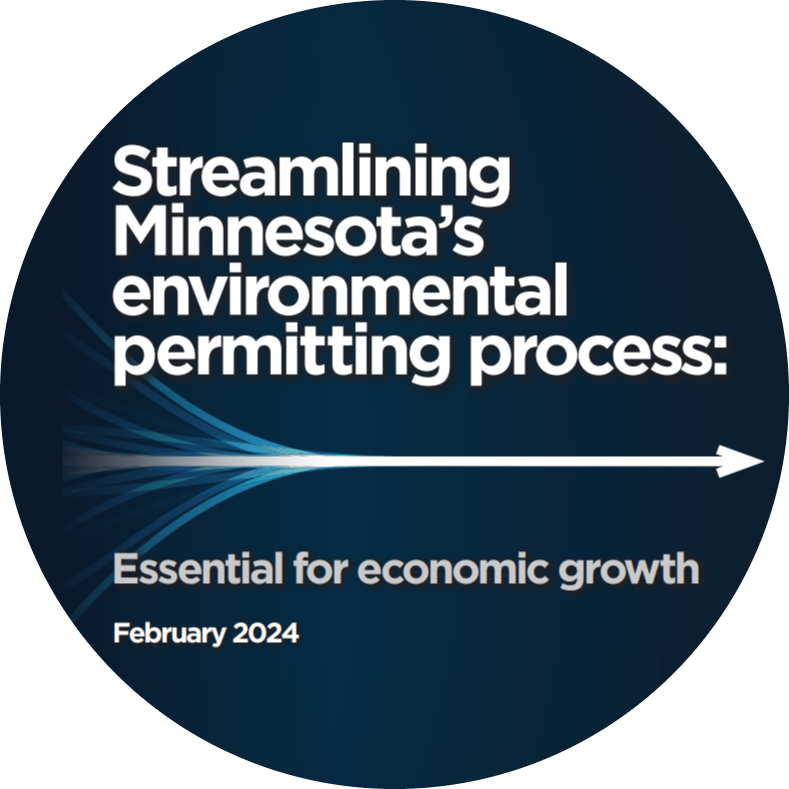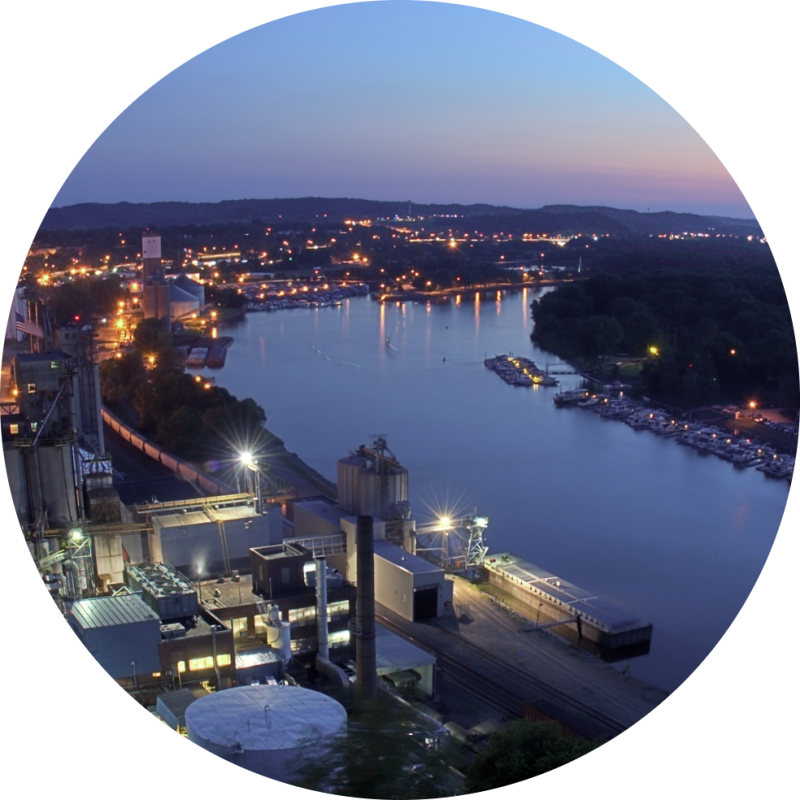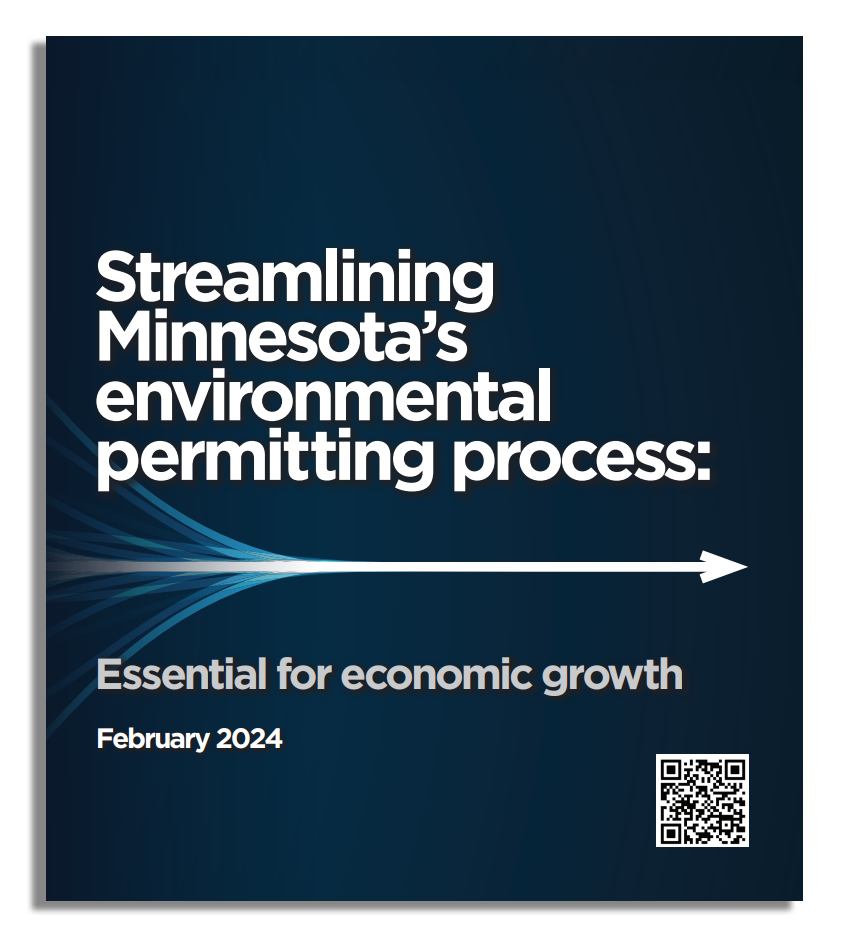Streamlining Minnesota’s environmental permitting process: Recommendations for improvement
Streamlining Minnesota’s permitting and environmental programs could unlock critical investments to build on the state’s diverse economic strengths while maintaining rigorous protection of the natural environment. Achieving this is an opportunity and imperative for the state’s economy in the years ahead.
Any meaningful changes will require a sustained commitment by leadership among Minnesota’s regulatory agencies, policymakers, communities and businesses. Collaboration across these groups is also needed to achieve long-lasting improvements in the way the state supports economic development and protects its cherished natural resources.
This report identifies a menu of actionable changes that could improve timeliness and reduce uncertainty in Minnesota’s environmental permitting and review programs. These recommendations are not an exhaustive list of improvements. Yet they represent win-win opportunities that could allow greater efficiency and quality in the state’s regulatory system. The report’s recommendations aim at three key issues that need to be addressed in Minnesota’s permitting system.
Minnesota must reduce the time it takes to issue priority Tier 2 air and water permits, bringing average and median timeframes closer to the agency’s 150-day goal.
The data reveal a stark divide in how Minnesota processes Tier 1 and Tier 2 air and water permits. Tier 1 permits, which regulate lower-impact facilities and do not involve public comment periods, are often issued to applicants within a matter of days or weeks. The MPCA issued 90% of all Tier 1 air permits within its 90-day goal in 2022.
However, only 9% were issued within the agency’s 150-day goal for Tier 2 air permits. Larger or more complex facilities requiring a Tier 2 air or water permit – which are written for the individual facility and involve public comment periods – routinely wait over a year before gaining authorization to start construction to build or expand. Over the past five years, the average duration to issue a priority Tier 2 air permit was 586 days, and the average duration to issue a new priority Tier 2 industrial water permit was 476 days. Some projects take much longer, exceeding 1,000 days to issue or modify a permit.
Excessive delays put Minnesota at a steep disadvantage when competing with other states for large economic development projects.
This has a cost to Minnesota’s economy. PNG estimates that Minnesota could improve its annual economic output by up to $960 million by issuing air permits in a similar timeframe to its regional peers like Wisconsin and Illinois. Businesses interviewed by the Minnesota Chamber Foundation affirmed the impact that permitting delays have on their ability to add equipment, expand or build new facilities.
Large facilities understandably must face robust permitting standards, allowing regulators to assess potential impacts and communities to express input on projects that directly impact them. These are essential processes that protect the environment and build trust between communities and industry.
Yet other states have proven that high environmental standards and efficient decision-making are not mutually exclusive. Illinois – a state with similar commitments to environmental protection as Minnesota – averaged just 110 days to issue federal air permits for new capital investment projects over the past five years, compared to 656 days to issue the same kind of permits in Minnesota.
Over the past five years, the average
duration to issue a priority Tier 2
air permit was 586 days and the
average duration to issue a new priority
Tier 2 industrial water permit was 476 days.
In many cases, faster permit review times could result in direct environmental benefits as well. One business we interviewed described a scenario where they sought to install new equipment that would reduce their emissions at the facility. Yet modifying their air permit to gain authorization for this project took over a year, delaying their ability to upgrade the equipment at their plant.
Leadership within Minnesota’s regulatory agencies should prioritize reducing the time it takes to issue Tier 2 air and water permits, bringing average and median timeframes closer to the MPCA’s 150-day goal. Doing so could improve economic development outcomes without compromising the high environmental standards that regulate facility activities.
For example, the MPCA could enhance its expedited permit review program intended to fast-track permitting reviews for time-sensitive or economically impactful projects. Some states, like Wyoming, utilize external capacity from third-party permit professionals to assist in gathering and drafting information on applications, freeing up agency staff time for decision-making. While such an approach is authorized under current Minnesota statutes, it does not appear to be actively used for expedited reviews.
Minnesota could seek ways to help more companies utilize Tier 1 permits, which have a track record of being issued efficiently and offer greater flexibility to permittees. This could be particularly effective for companies making environmentally beneficial changes to their facility, rather than going through the complex amendment process. These are just two examples of win-win strategies that could streamline permitting activities while ensuring regulators are fully equipped to exercise authority over decision-making.
State regulators should address backlogs of permit renewals and minor facility changes for air and water permits.
In addition to fast-tracking priority economic development projects, the MPCA should seek to address the backlog of permit renewals and other non-priority applications that can keep companies waiting years to receive an updated permit. This could allow hundreds of facilities in Minnesota to operate with an up-to-date air or water permit, providing greater assurance to businesses and communities.
Findings from this report show that non-priority Tier 2 air permits take an average of 1,295 days to be issued, with Title V permit renewals averaging nearly 1,500 days. Individual industrial water permits (NPDES/SDS permits) face deep backlogs as well. Of the 226 NPDES/SDS permits currently administered by the MPCA, 152 are administratively continued (i.e. past the expiration date, but still in effect) as of the end of Q3 2023. The average amount of time these permits are administratively continued is 6.5 years, with the longest being 23 years.
Reducing these backlogs does not deliver as much economic impact to the state as does reducing timelines for priority capital investment projects. But it would improve the overall administration of Minnesota’s permitting system and reduce ambiguity and frustration for permit holders who often wait years to renew expired permits or make minor modifications to existing ones.
Minnesota should improve transparency, certainty and collaboration throughout Minnesota’s permitting and environmental review programs.
State regulatory agencies should identify and implement reforms that make Minnesota’s permitting and environmental review programs more transparent and certain. Doing so would improve businesses’ ability to predict and plan capital investment projects and better understand their regulatory compliance obligations. Businesses must know where the finish line is and reasonably predict the path to cross it. Greater transparency would also benefit policymakers and the public, helping them better track and understand how Minnesota’s environmental programs are performing and where further adjustments are needed.
This report identifies numerous opportunities across the state’s air, water, wetland and environmental review programs that could reduce complexity and improve transparency in the process.
For example, the MPCA could provide businesses with a basic schedule at the outset of a proposed project that outlines the various steps and timelines they can expect as the agency reviews their application, performs modeling and other analyses, drafts a permit and sends it out for public comment. Input from consultants and businesses indicate that such a schedule is not typically provided to applicants in Minnesota. In cases where a schedule is provided, however, it can greatly aid the business’s ability to move forward with confidence in a capital investment.
Findings from this report show
that non-priority Tier 2 air permits
take an average of 1,263 days to be
issued, with Title V permit renewals
averaging nearly 1,500 days.
Another opportunity is to expand support services that provide guidance to businesses for permit applications or compliance questions. The MPCA currently has a Small Business Ombudsman program that assists small businesses with fewer than 100 employees. Expanding a service like this to businesses of any size – or enhancing programs like Minnesota Business First Stop – could offer greater opportunities for dialogue and collaboration for companies trying to navigate complex permitting processes.
Improvements in transparency and certainty could be particularly impactful to Minnesota’s environmental review program. Environmental review requires agencies to assess potential impacts of proposed projects subject to their jurisdiction and informs the public about their decision-making. This program – which can involve one or more levels of review through an EAW, EIS or Alternative Urban Areawide Review (AUAR) – is reserved for some of the state’s largest projects and has an outsized impact on economic development.
Despite the importance of this program, there is little public data on key performance metrics, including timeframes for project proponents to complete the review requirements. Past research from the OLA and feedback from businesses and consultants indicates that reviews often take years to complete. A first step in addressing these concerns should be to create detailed and reliable reporting tools to better track project outcomes. Further reforms could streamline the program by eliminating redundant steps that slow down the process without providing additional information about the project.





